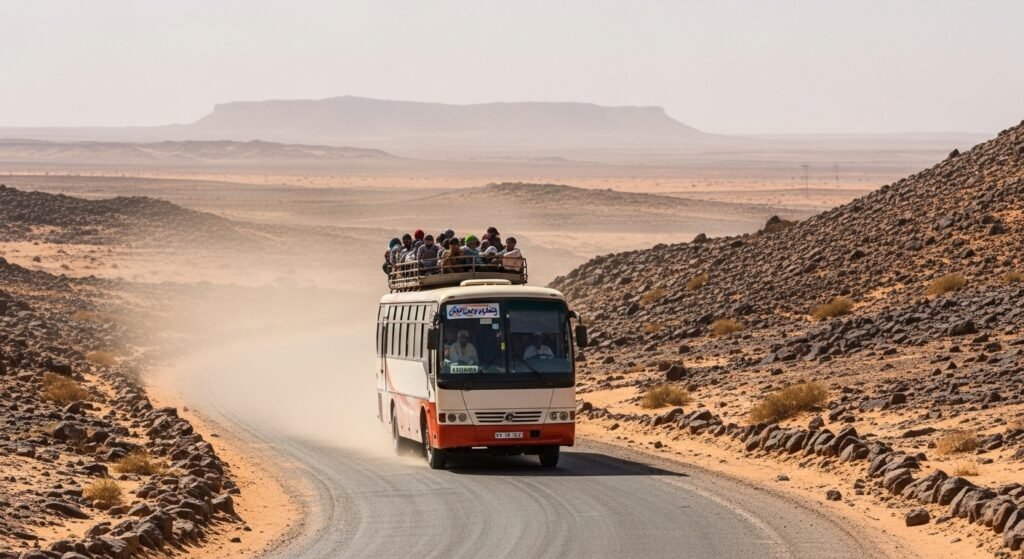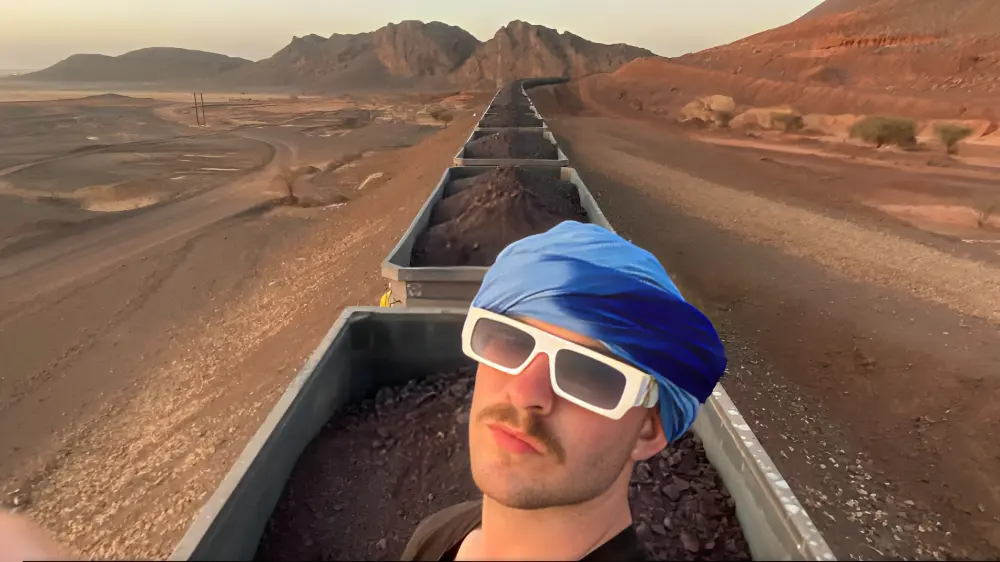Mauritania’s Iron-Ore Train Journey Through the Sahara
The Mauritania Railway, commonly referred to as the Iron-Ore Train, connects deep Saharan desert areas to Atlantic coast ports via three kilometers of track that carry 200 wagons full of iron ore from Zouerat mines to Nouadhibou port – making this route as much about industry and human connection as about survival, desert life, and desert survival.
Origins and the Rise of a Desert Railway
- Mauritius’ iron-ore line dates back to 1960, when construction began and was completed by 1963, spanning 704 kilometres between Zouerat and Nouadhibou.
- Société Nationale Industrielle et Minière (SNIM), a state mining and industrial company, constructed this railway to link rich iron ore deposits in the Sahara to Atlantic coast shipping ports.
- Over time, the route became a lifeline for remote mining towns in northern Mauritania. For many residents, the train offers one of the few dependable mass transit options in a harsh, sparsely settled region.
- Since their introduction, passengers have shared wagons loaded with iron ore or boarded attached passenger cars – often under less-than-ideal conditions.
- Today’s train is one of the longest and heaviest ever constructed: some consist of over 200 ore wagons spanning 2.5-3 km in length and transporting tens of thousands of tonnes at once.
- From its roots in resource extraction to its current role connecting remote communities, the rail line marks this journey as more than an experience; it serves as an industrial corridor spanning the Sahara.

The Route, Distance & Landscape
Route Highlights
- Start in Zouerat, the desert mining town in the Tiris Zemmour region.
- Midpoint/Stop: Choum is a village close to the Western Sahara border where trains often make brief stops before continuing further north.
- Destination: Nouadhibou, the Atlantic-coast port city.
Distance & Duration
- Track length: ~704 km.
- Journey Time: Varies considerably and typically requires 16-20 hours depending on loading, direction, and stops.
- This route winds across vast desert plateaus, dunes, semi-arid wastelands, and coastal fringe — creating a striking contrast between the Sahara interior and Atlantic margin
Why the length matters
- With trains reaching 2.5 km or more and carrying over 17,000 tonnes of ore, the physical scale highlights the logistical and environmental challenges of transporting raw materials through extreme terrain.
- For a traveler, this is not simply a long train ride; it’s a passage through desert time, remote geography, and human endeavor.

Passenger Experience & Legal Realities
Modes of travel
There are two main ways travellers can engage with the railway:
- Official passenger cars attached to the ore train, with minimal spaces, basic seating, and minimal amenities.
- Unauthorised riding on ore wagons or open hoppers, popular with adventurous travellers but is legally and physically risky.
Legal and safety notes
- SNIM allows passenger access via designated cars. However, many blogs confirm that the passenger car is quite basic, and competition for seats is intense
- Riding ore wagons remains both illegal and hazardous: sharp drops, dust exposure, temperature extremes, and lack of shelter are serious risks that must be managed carefully to remain safe.
- Visitors should purchase tickets ahead of time and travel in an official carriage rather than taking unnecessary risks on freight wagons.
What the journey feels like
Travelling across the Sahara for 700+ km in a freight train is unlike any typical rail experience. At dusk, you may cross the dunes, under starlit skies, into the cool desert night. At dawn, you reach the coast and experience a sharp climate and landscape shift.
For local passengers, the train serves not only as transport but as part of everyday life, hauling goods, reaching remote camps, or simply moving between towns. That human dimension adds depth beyond the adventure angle
Preparation & Practical Tips
Essentials to pack
- Warm layers, desert nights after the heat of the day can drop sharply.
- Ample water and snacks, official services are minimal or non-existent.
- Sun protection (sunglasses, sunscreen, and a hat), along with comfortable footwear, is essential when embarking and disembarking a vessel.
- A paper copy of the ticket/booking, local currency, and an essential first-aid kit should all be included with each excursion.
When to ride and direction matter
The direction from Zouérat → Nouadhibou typically means loaded wagons and a more “classic” ore-train experience.
Nouadhibou → Zouérat may use empty wagons; conditions may differ
Expect schedule flexibility: departure times and arrivals often shift due to freight load, track conditions, or desert weather.
Cultural & ethical awareness
- Treat the journey as a transport reality, not just a “thrill ride.”
- Recognize the local usage of the train by residents living along the line. Avoid framing only as “extreme tourism”.
- Respect desert communities and their environment by refraining from littering, trespassing, or disregarding local guidelines.
- Acknowledging its historical and economic context, the train is connected to Mauritania’s mining industries and national infrastructure, not simply tourism

Economic Importance & Environmental Challenges
Economic backbone
- The railway allows large-scale transport of ore from remote sites to the Atlantic coast, sending it for processing and shipping overseas.
- Iron ore is a major pillar of Mauritania’s export earnings, at times accounting for around 30-40 % of national export revenue.
Technical upgrades & sustainability
.SNIM and the Mauritanian authorities have made considerable investments to modernize infrastructure: expanding capacity, upgrading ore handling systems, and making small steps toward mitigating environmental impact.
However, this route passes through fragile desert ecosystems, while its harsh climate poses infrastructure challenges (sand encroachment, shifting ground, and track maintenance).
Traveller implications
- Understanding that the train is primarily industrial adds respect and humility to the journey.
- Recognizing local livelihoods tied to the train supports a more responsible appreciation of the journey, for both visitor and resident alike.
Safety, Respect & Ethical Travel
Key safety reminders
- Always travel in official passenger accommodation — never board freight ore wagons without prior supervision.
- Be mindful of both weather and daylight when travelling at night in an open desert: temperatures, winds, and isolation could put you in harm’s way.
- Stay hydrated to protect your eyes and skin from dust, sunlight, and iron-ore particles by staying hydrated; ensure they are free from dust.
- Adhere to local regulations and track-zone rules — much of the desert route passes through remote terrain where assistance may be limited.
Ethical travel behaviour
- Avoid portraying local passengers as “daredevils” or reducing their experience to a photo-op.
- Talk to local travellers respectfully, recognise their everyday use of the line.
- Avoid dangerous stunts or encouraging illegal boarding for “Instagram moments.”
- Support local communities: buy water, supplies, engage with locals respectfully, and leave no trace in the environment.
Final Thoughts: More Than A Train Ride
This is not just a train journey; it’s a corridor through desert time, industry, and human endurance. The Mauritania Railway runs deep across the Sahara and emerges at the Atlantic, a physical, logistical, and cultural link. For the visitor, it offers a rare insight into one of Africa’s large-scale mining industries and a remote landscape seldom traveled by outsiders. For Mauritanians, it remains a vital transport artery, a source of income, and a connection in vast, harsh terrain. Approach the journey with respect, preparation, and humility, and it becomes more than an experience; it becomes a reflection of adaptation, persistence, and movement across one of the world’s most extreme landscapes.
Frequently Asked Questions
What is the cost to ride the train in the authorised passenger carriage?
A: Official passenger carriage tickets are extremely reasonable — reports estimate approximately EUR6-15, depending on exchange rates, for a one-seat ticket.
Always confirm the price locally as rates can change over time.
Are tourists permitted to ride from either direction on the route?
A: Yes – the train from Zouerat to Nouadhibou offers both ways, each providing its own experience: loaded wagons heading outbound while emptier wagons returning inland.
Pick the direction that suits your comfort and schedule.
What should I bring for the journey?
A: Essential items include: dust-protection (goggles/mask), plenty of water, snacks, warm layers (desert nights get cold), sun-protection (hat/sunscreen), and a power bank
Prepare for minimal facilities on board
